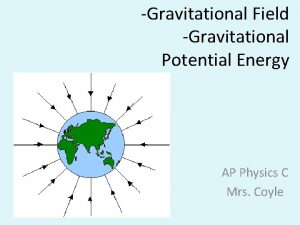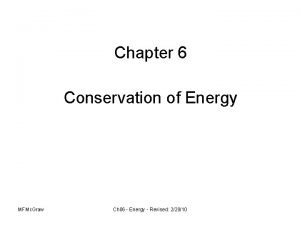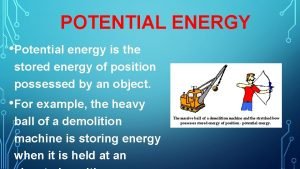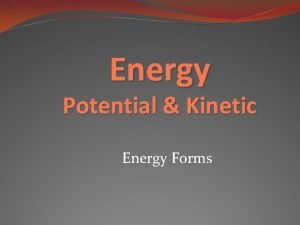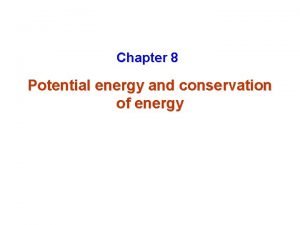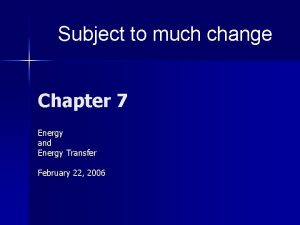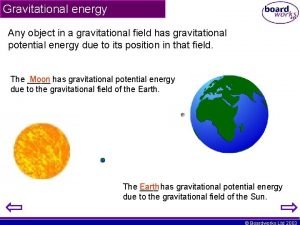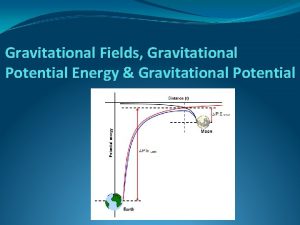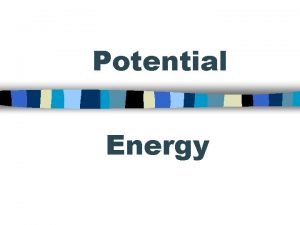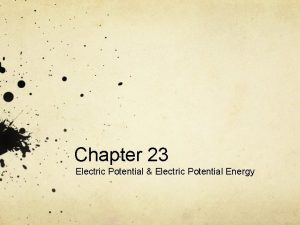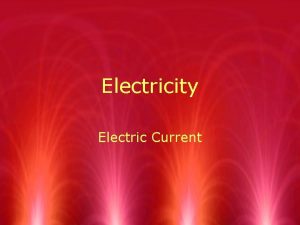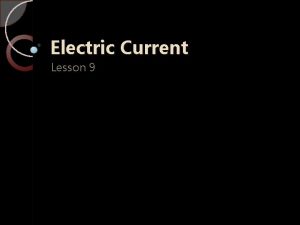Electric Current Electric Potential Energy Similar to gravitational






















- Slides: 22

Electric Current

Electric Potential Energy • Similar to gravitational potential energy. With GPE an object has energy by virtue of its position, say in a force field. • Like wise a charged object can have potential energy by virtue of its location in an electric field. • Just as work is required to lift an object against the gravitational field of the earth, work is required to push a charged particle against the electric field of another charged object.

Electric Potential • Rather than deal with the total potential energy of a group of charges it is convenient when working with electricity to consider electric potential. • Electric potential is the total electric potential energy divided by the amount of charge. • Since potential energy is measured in joules and charge is measured in coulombs,

Voltage Sources • Charges do not flow unless there is a potential difference. A sustained current requires a suitable “electric pump” to provide a sustained potential difference. This is called a voltage source. • Dry cell and wet cell batteries energy is released in a chemical reaction occurring inside of the cell and is converted to electric energy. • A generator uses mechanical energy to produce electric energy.

Question 1 • Static electricity is called such because … A. B. C. D. It can defeat gravity. It moves. It does not move. It gives you a bad hair day.

Flow of Charge • A Charge will flow across a conductor when there is a difference in potential (voltage) across the ends of a conductor. • The flow will continue until both ends reach the same potential. • Example if you use a wire and touch one end to ground and the other to a charged Van de Graff generator, a surge of charge would flow through the wire. The flow would be brief, however, for the sphere would quickly reach a common potential with the ground.

Electric Current • The flow of electric charge is Electric Current. • In solid conductors, it is the electrons that carry the charge through the circuit. • Electric current is measured in amperes, symbol A. It is the same as one coulomb of charge per second. (a coulomb is the electric charge of 6. 25 billion electrons) • Note: a current-carrying wire does not have a net electric charge. Due to the number of electrons in a wire is equal to the number of protons in the atomic nuclei.

Electric Power • When a charge moves in a circuit, it does work. • The rate at which work is done, or converted to another form such as mechanical energy, is called electric power. P = V x I 1 watt = (1 volt) x (1 ampere) Voltage has units of volts, Current has units of amperes and Power in watts.

Question 2 • A 100 watt light bulb is plugged in to an ordinary outlet which has a voltage of 120 v. How much current flowing through the light bulb filament? n Know: P=100 W; V=120 v; P=VI A. B. C. D. 12, 000 A 1. 2 A 220 A 0. 83 A

Electricity • Lords of Lightning, Belfast Germany 2012 (4 MILLION VOLTS) • Massive Lightning Strike within 200 m

Electrical Resistance • This is the resistance that a conductor offers to the flow of charge. • Resistance depends on many factors: ▫ The resistance is less in thick wires. ▫ The longer the wire the greater the resistance. ▫ The greater the temperature, the more the atoms within a conductor move, the greater the resistance.

Resistors • Resistors dissipate energy by heat. The material of the resistor is conductive, but not as conductive as the wire used to connect circuit components. The symbol for a resistor is: 15 W

Look inside a Resistor

Resistor in a Circuit i

Question 3 • Your body acts like a resistor when a voltage is applied to your body. How can you decrease your resistance? A. B. C. D. Go swimming in the ocean Lay out in the hot sun in August! My cat’s name is mittens Replace your blood with Distilled Water

Voltage • Voltage is sometimes referred to as a pressure. For instance if the voltage that comes out of your wall outlet is 120 volts then that is how hard the ‘wall outlet can push’. • When 120 v ‘sees’ a resistance of 1 Ω then it is able to easily ‘push’ the resistance. • When 120 v ‘sees’ a resistance of 5, 000 Ω then it is unable to ‘push’ the resistance.

V Ohm’s Law I R • Georg Simon Ohm discovered that the amount of current in a circuit is directly proportional to the voltage impressed across the circuit, and inversely proportional to the resistance of the circuit. • I=V÷R (Current = Voltage / Resistance) • Therefore if the resistance is constant, if you double the voltage you double the current.

• Analogy of a water circuit and an electric circuit.

Electric Shock • Electric shock is caused by current flowing through your body. From Ohm’s law we can see that this current depends on the voltage applied and the resistance of your body. • Your body’s resistance can vary form 100 ohms if you are soaked with salt water, to 500, 000 ohms if you are very dry. Current Effect in Ampere s 0. 001 Can be felt 0. 005 Painful 0. 010 Involuntary muscle contractions (spasms 0. 015 Loss of muscle control 0. 070 Through the heart; serious disruption; probably fatal if current lasts for more than a second.

Question 4 • Lets say you are dehydrated to the point that you are about to pass out. Your body has a resistance of 300, 000 Ω. An you decide to plug your finger in to the wall outlet containing 120 v. What current passes through your body? DO NOT TRY THIS AT HOME! n Know: R=300, 000 Ω; V=120 v; V=IR n 0. 0004 A B. 2500 A C. 3. 6 e 7 A D. 0. 002 A A.

Question 5 • Lets say you go take a swim in the ocean. Your body has a resistance of 100 Ω. After your swim you decide to plug your finger in to the wall outlet containing 120 v. What current passes through your body? DO NOT TRY THIS AT HOME! n Know: R=100 Ω; V=120 v; V=IR n 1. 2 A B. 0. 83 A C. 12, 000 A D. 20 A A.

References Dilbert Cartoon http: //dilbert. com/strips/c omic/1990 -01 -10/ • Slides obtained and adapted from Ms. Jenkins and Ms. Hattori Guyer H. S. • Information and pictures, unless noted other wise, from Glenco Physics principals and problems Texas Edition • Pictures on slides 6, 11 and 18 come from Hewitt Conceptual Physics.
 Electric potential energy definition
Electric potential energy definition Formula for total mechanical energy
Formula for total mechanical energy Gravitational potential energy vs kinetic energy
Gravitational potential energy vs kinetic energy Units of electric potential energy
Units of electric potential energy Pe q
Pe q Gravitational potential energy equation
Gravitational potential energy equation Gravitational potential energy
Gravitational potential energy Gravitational potential energy
Gravitational potential energy Find mechanical energy
Find mechanical energy What is potential energy
What is potential energy Electricity examples
Electricity examples Mgh si units
Mgh si units Thermal energy formula
Thermal energy formula Potential energy formula
Potential energy formula What is gravitational potential energy
What is gravitational potential energy Gpe formula rearrange
Gpe formula rearrange Gravitational potential energy
Gravitational potential energy Equation for efficiency
Equation for efficiency Energy formula physics
Energy formula physics Define electric potential and potential difference.
Define electric potential and potential difference. Electric potential
Electric potential Potential energy due to point charges
Potential energy due to point charges Electric potential formula physics
Electric potential formula physics







